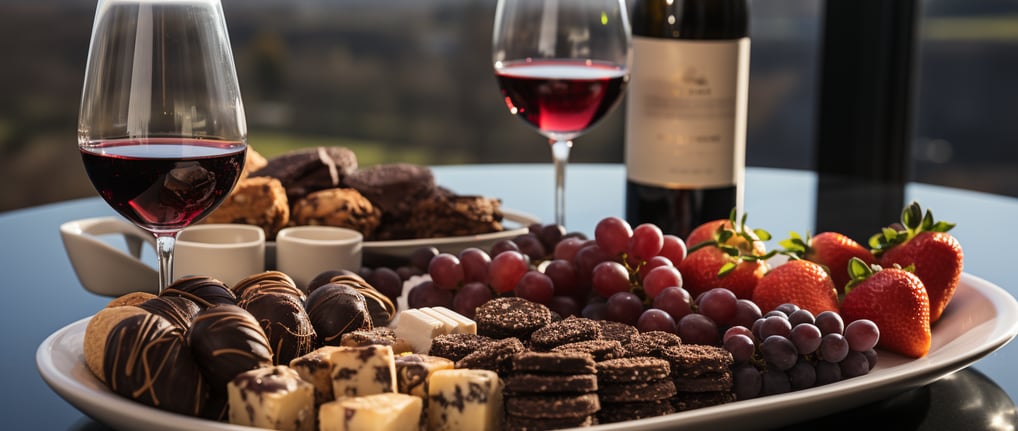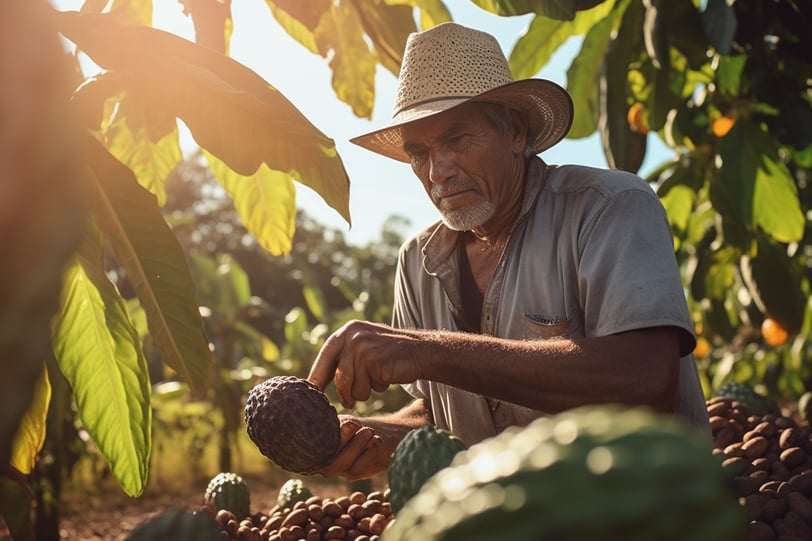Indulge in a Chocolate and Wine Tour
If you're a connoisseur of the finer things in life, then a chocolate and wine tour should be on the top of your travel list. Indulging in the rich flavors of chocolate and the velvety depths of wine is a truly sensory experience that will titillate your taste buds and leave you craving for more. So pack your bags and prepare your palate for an adventure that will take you on a delectable journey of discovery.

Before embarking on your chocolate and wine tour, it's important to understand the art of pairing these two heavenly delights. The combination of chocolate and wine creates a symphony of flavors that can elevate your gastronomic experience to new heights. But how do you know which chocolate goes best with which wine?
The science behind the pairing lies in the delicate balance of flavors, textures, and aromas. The tannins in wine and the bitterness of dark chocolate can complement each other, while the acidity in wine can cut through the sweetness of milk chocolate. Key principles, such as matching intensity, seeking complementary flavors, and exploring contrasts, are fundamental to creating harmonious pairings that will dazzle your palate.
When it comes to pairing chocolate and wine, there are endless possibilities to explore. Let's delve deeper into the world of chocolate and wine pairing and discover some intriguing combinations that will leave you craving for more on your next romantic holiday.
One classic pairing that never fails to impress is a rich and velvety Cabernet Sauvignon with a dark chocolate truffle. The bold flavors of the wine, with notes of blackcurrant and oak, perfectly complement the intense bitterness of the dark chocolate. As you take a sip of the wine and let it mingle with the chocolate on your palate, you'll experience a symphony of flavors that dance harmoniously.
If you're looking for a more adventurous pairing, try a fruity and vibrant Pinot Noir with a milk chocolate-covered raspberry. The bright acidity of the wine cuts through the sweetness of the chocolate, while the burst of juicy raspberry adds a refreshing twist to the combination. It's a delightful balance of flavors that will leave you pleasantly surprised.
For those who prefer white chocolate, a buttery Chardonnay can be the perfect match. The creamy texture of the chocolate blends seamlessly with the smoothness of the wine, creating a luxurious mouthfeel. The subtle hints of vanilla and tropical fruits in the Chardonnay add a delightful complexity to the pairing, making it a true indulgence for your taste buds.
As you continue your chocolate and wine journey, don't forget to explore the world of dessert wines. A luscious Port or a sweet Moscato can be the ideal companion for a decadent chocolate mousse or a rich chocolate cake. The sweetness of the dessert wine enhances the richness of the chocolate, creating a heavenly combination that will satisfy even the most discerning sweet tooth.
Remember, the art of chocolate and wine pairing is all about experimentation and personal preference. Don't be afraid to try different combinations and discover your own unique favorites. Whether you're a chocolate lover, a wine enthusiast, or both, the world of chocolate and wine pairing is a delightful adventure waiting to be explored.
Exploring the World of Chocolate

To truly appreciate the magic of chocolate, it's essential to delve into its fascinating world. The process of chocolate making is an intricate dance of art and science. From the cultivation of cacao beans to the delicate process of tempering and molding, each step contributes to the creation of a delectable masterpiece.
Let's start by exploring the cultivation of cacao beans, the foundation of all chocolate. Cacao trees thrive in tropical regions, where they are carefully nurtured to produce the finest quality beans. These trees require specific conditions, including a humid climate, well-drained soil, and just the right amount of rainfall. The cultivation process involves meticulous care, as farmers monitor the growth and health of the trees, ensuring optimal conditions for the cacao pods to develop.
Once the cacao pods are ripe, they are carefully harvested by hand. This labor-intensive process requires skilled workers who can identify the perfect moment to pluck the pods from the trees. The pods are then cracked open, revealing a treasure trove of cacao beans nestled inside. These beans are carefully extracted and left to ferment, a crucial step that enhances the flavor and aroma of the chocolate.
After fermentation, the beans are dried to remove excess moisture. This step is crucial in preventing the growth of mold and bacteria, ensuring the beans remain in perfect condition. The dried beans are then shipped to chocolate factories around the world, where they undergo a series of processes to transform them into the chocolate we know and love.
The first step in chocolate production is roasting the beans. This process involves carefully heating the beans to develop their rich flavors and aromas. The duration and temperature of roasting can vary, depending on the desired characteristics of the chocolate. Once roasted, the beans are cracked and winnowed to remove the outer shell, leaving behind the cocoa nibs.
The cocoa nibs are then ground into a thick paste called chocolate liquor. This liquor serves as the base for all types of chocolate. To create dark chocolate, the liquor is further processed to remove some of the cocoa butter, resulting in a higher percentage of cacao solids. For milk chocolate, the liquor is combined with milk powder and sugar, creating a creamy and sweet delight. White chocolate, on the other hand, is made by blending cocoa butter, sugar, and milk solids, without any cocoa solids.
Once the chocolate has been formulated, it undergoes a process called conching. This involves continuously stirring and kneading the chocolate to refine its texture and flavor. The duration of conching can vary, ranging from a few hours to several days, depending on the desired outcome. This step is crucial in creating a smooth and velvety chocolate experience.
Finally, the chocolate is tempered, a process that involves carefully heating and cooling the chocolate to stabilize its crystalline structure. This ensures that the chocolate has a glossy appearance, a satisfying snap, and a smooth mouthfeel. The tempered chocolate is then poured into molds, where it is left to cool and solidify into the familiar shapes we associate with chocolate bars and truffles.
Exploring the nuances of these flavors will open your eyes to the vast possibilities of chocolate indulgence. Whether you prefer the bold intensity of dark chocolate, the creamy decadence of milk chocolate, or the velvety sweetness of white chocolate, there is a world of flavors waiting to be discovered. So take a moment to savor each bite, and let the magic of chocolate transport you to a realm of pure bliss.
Diving into the Wine Universe
Just as chocolate has its own world to explore, so does wine. Understanding wine varieties is key to unraveling the mysteries of this ancient elixir. From the fruity and vibrant notes of red wines to the crisp and refreshing whites, each bottle has its tale to tell. Whether your bottle comes from a winery in France, Canada, Thailand, or India, each one will surely tell a story as sweet as chocolate.
The art of wine tasting is an essential skill for any chocolate and wine tour enthusiast. It's not simply about drinking wine; it's about savoring each sip, appreciating the different aromas and flavors, and understanding the nuances that make each wine unique. A swirl, a sniff, and a sip will transport you to vineyards around the world, where you can imagine the sun-drenched hills and the careful hands that crafted these liquid treasures.
Planning Your Chocolate and Wine Tour
Now that you're armed with knowledge about chocolate and wine, it's time to plan your ultimate indulgence. Choosing the right destination is crucial for a truly immersive experience. Countries renowned for their chocolate and wine production, such as Belgium, France, and Italy, offer a plethora of mouthwatering options.
When it comes to accommodations, look for hotels or bed and breakfasts nestled in the heart of wine regions or near chocolate factories. Imagine waking up to the intoxicating aroma of freshly roasted cacao, or enjoying a glass of velvety red as the sun sets over rolling vineyards. It's the perfect way to fully immerse yourself in the world of chocolate and wine.
Tips for Enhancing Your Chocolate and Wine Tour Experience
When you finally embark on your chocolate and wine tour, there are a few things you can do to enhance your experience even further. Knowing how to taste and appreciate the pairings is crucial. Allow the flavors to dance on your tongue, savoring each bite of chocolate and each sip of wine. Take note of the interplay between the two and the way different combinations awaken your senses.
But don't stop at just savoring the flavors; make the most of your tour by immersing yourself in the surroundings. Explore the picturesque vineyards, take a guided tour of a chocolate factory, or indulge in a culinary workshop where you can learn the art of making your own delectable creations. The possibilities are as endless as the flavors waiting to be discovered.
Making the Most of Your Tour
Your chocolate and wine tour is not just about the indulgence; it's about creating lasting memories. So make the most of your journey by fully immersing yourself in the experience. Keep an open mind and be willing to try new flavors and pairings that you never thought possible.
Remember, chocolate and wine are like the sunrise and sunset of the culinary world. They are meant to be savored, enjoyed, and celebrated. So go forth, my fellow gastronomes, and embark on a chocolate and wine tour that will transport you to new heights of indulgence. Cheers to a journey that will delight your senses and leave you craving for more.